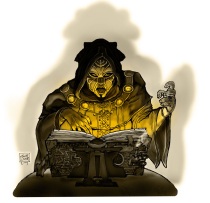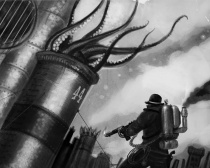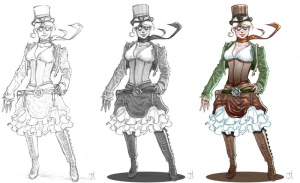Welcome, dear Guest!
The last week at Steamagination’s Facebook was Lovecraftian Week, a time full of forbidden knowledge and extraterrestrial horrors. Today I have for you a compilation of all goods that appeared on FB during that week plus one extra gadget – The picture of Filip Liebkraft. Enjoy!
Gadgets
The Book of Offerings (20 XP)
A rare and forbidden magical volume encouraging the reader to offer a part of himself in exchange for the lore of alien, hungry entities.
Or: an invisible imp advisor, a ritual knife of an alien cult, arcane formulas tattooed into one’s skin.
Traits: once per session: any ritualist power*, Enchance Power spell, any other ritualist spell*. Special: when using spells from this book you can sacrifice a Reputation, Constitution or Wealth point to gain an extra die just like ritualists do.
*Choose one when you acquire the gadget.
Fateful cookies (15 XP)
Fortune cookies (or tea cakes) with eldritch secrets instead of prophecies. Eat them regularly and you’ll soon be both well-versed in occult matters and fearless – or maybe too mad to fear anything?
Or: tea leaves of bad omen, collection of non-Euclidean statues, a psychoanalyst seeking occult meaning in his patient’s dreams.
Traits: courage +3, occultism +3, token: +5 in a conflict against an enemy who causes Fear.
The picture of Filip Liebkraft (10 XP)
A portrait of famous Wotanian occultist who probably was kidnapped by venrierist to help in contact with the Elder Gods. The picture is said to have gone mad instead of Liebkraft himself. If it talks to you in your dreams, don’t worry – but be sure not to sleepwalk for you may enter the picture and never come back.
Or: Dr Zauberberger’s Remote Investigator, crystal ball with zoom option, clockwork third eye.
Effects: occultism +3, special action: find out any piece of lore related to the Elder Gods or Elder Races.
Special thanks to Liebkraft from Yog-Sothoth.com for giving me an inspiration for this gadget!
Saint Mario’s Spyglass (10 XP)
Some say that Mario Slavio, the most curious traveler in the Middle Ages was made a saint because he remained a faithful dualist despite the things he has seen during his voyages. Most of them have been seen using this spyglass.
Or: Dr Zauberberger’s Remote Investigator, crystal ball with zoom option, clockwork third eye.
Effects: spot +3, special: you can always use analysis or occultism to analyze the things you see through this spyglass as if you were standing next to them.
Walter Jackson’s notes (10 XP)
The notebook of a consulting detective that stopped at least dozen unholy rites, arrested the high priest of The Dancer Throught The Aeons and is currently considered lost in time and space.
Or: “Be a cultist!” disguise set, fake tattoo of a dangerous cult, talking skull of an ancient priest-king
Traits: occultism +3; +3 to social actions against cultists, warlocks and madmen.
Feats
Alien Heritage (5 XP)
Strange things happen around you and maybe even in you. They may have happened since your birth or have begun after a strange event in your past.
Effect: once per session you can add a second card to the result of the roll at a cost of Reputation or Constitution point. This card represents something strange and shocking, like gills opening on your neck or a mysterious voice advising you on swordplay. You can’t use this ability when you play a second card by exhausting a power.
Fearless! (10 XP)
Requirements: trained in courage.
Effect: you draw an additional card when you succeed on a Fear test (normally it takes a raise). If Fear was caused by a creature during a conflict, a raise on that roll gives you an extra d10 for your next action against this creature.
Bend reality – a new spell
You can suddenly turn a favorable opportunity used by your opponent to your advantage.
Variants: Steam-powered Fate Depolarizer, a leak of matter from the tenth dimension, minor time manipulation, spinning a narrative of the real world.
Requirements: use this spell only when your enemy is playing a card. Discard all cards from your hand, lose a Reputation point (due to the mind-shattering scope of this spell) and make a roll of your arcane skill with TN dependent on the card: 2-10 means TN 10, J-K TN 14, Ace TN 20 and the Joker TN 30.
Effect: if your roll succeeds the card played by your enemy gives him a penalty instead of a bonus, for example a roll result of 17 with an ace is 12 and not 22. If your enemy was using a card instead of rolling the dice his test simply fails.
Sanity loss – a new scar
Some monsters – demons, the Elder Races, some undead – may be so appalling that losing any conflict with them causes a loss of Composture instead of Agility or Brawn. A PC whose Composure is reduced to 0 in that way can regain it by getting a following scar:
Sanity loss: courage -3, occultism +3




